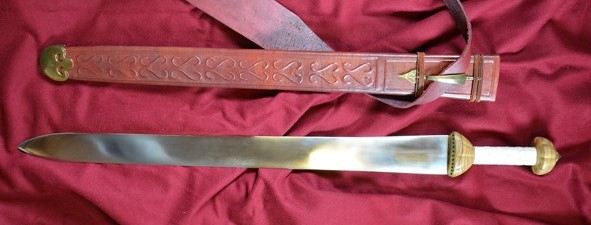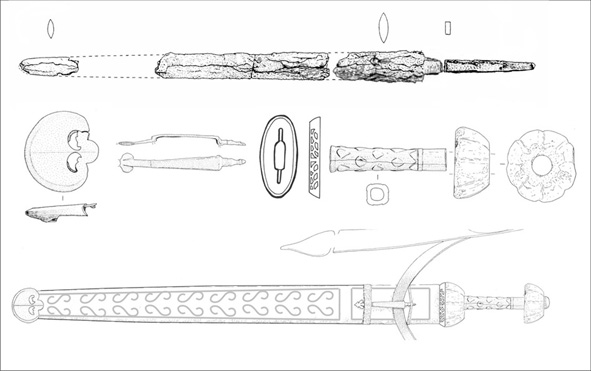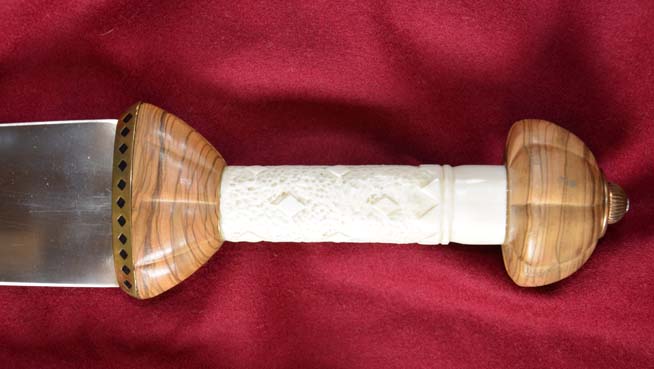Re-enactment, Archaeology, and the Ancient Rome & Greece Weekend II of IV: The Sword

The sword is one of the definitive weapons of the Roman soldier, right from the earliest days of the Empire. The Romans were very keen on swords, and gained much from contact (read conquering) the Iberians of Spain and Gauls of France. The carnage created by the slashes and thrusts of the Roman swords, including the gladius hispaniensis (c. 2nd-1st centuries BC) made a massive impact on their foes, physically and psychologically. The short gladius of the Early Imperial period (1st-2nd centuries AD) is an icon of Roman military history, essentially defining what a Roman sword looks like for most people. However, by the time of Dura-Europos in the mid-3rd century, the typical Roman sword was longer, what is often called a "spatha" ("spada" is still what a "sword" is in Italian). This is the ancestor of the "broadsword" of the mediaeval knight, and it is probably not a coincidence that by the 3rd century many Roman soldiers were actually horsemen. There are a number of fragments of these longer swords and their fittings amongst the finds from Dura-Europos. I contacted Leo "Tod" Todeschini, who is an accomplished craftsman and creator of museum-quality reproductions of mediaeval and ancient objects, including weaponry. Tod and I discussed making a replica based on these finds for my recreation of the equipment of a Roman soldier of Dura-Europos for the ROM's Ancient Rome & Greece weekend.
The final sword and scabbard is as you can see above. The blade itself was copied from the blade fragments from the site, all of lenticular section (a lens-shaped profile). The original pommel was actually made of cut rock-crystal, which would have been very fine, but I had Tod copy it in wood (he used olive wood). Judging by other Roman sword finds, the guard would be of the same material and design as the pommel, and so that is how it has been reproduced. The guard plate of bronze and the grip of bone are copying finds from the site. The sword is rather tip-heavy compared to the later mediaeval swords I am accustomed to using, but it is a very effective blade nonetheless.
The scabbard has a wooden core, as one of the excavated sword finds showed traces of wood which had been spirally bound in cloth. According to Tod, winding cloth around the wooden core is a known way to strengthen it. However, there seem to bet no depictions (wall-paintings, mosaics, reliefs) of sword scabbards of this time that show spiral binding, and so it probably also had a leather covering, typical of later swords. Unfortunately, none are preserved, and there are few informative depictions of the period. It might have been assumed that the leather was undecorated, which is a common assumption of Roman leatherwork reproductions, but since all the preserved materials typically show a lot of decoration, this may not be a sound assumption. However there are some reliefs from the Syrian site of Palmyra with scabbards, although they are not of Roman soldiers. These have scrolling decoration on them, and I hypothesized that they may have been created in the same way that later Middle Eastern sword scabbards are decorated, in which string is glued to the wooden core, and the fine leather is stretched over it. Tod was intrigued by the idea, and tried it, and it seems to have worked perfectly. The scabbard slide (by which the sword is hung by a strap that goes over the shoulder) and the chape (the metal end of the scabbard) are based on finds from Dura Europos.
The result is as you can see, above. But if you come to Ancient Greece and Rome weekend on June 15th you can see it in person!

A drawing of the reproduction Dura Europos sword (bottom) and the finds from the site that were copied to produce it (after Simon James' book on the finds from Dura-Europos).

The sword hilt.
